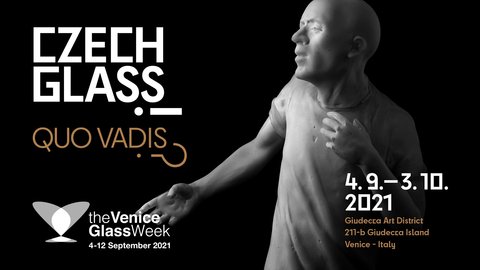







Jaroslav Róna
In the world of art, this versatile artist is known primarily as a sculptor and painter, to the more knowledgeable ones also as a performer, theatre and film artist, illustrator, draftsman or as a co-creator of architectural installations. However, only few people know that he holds a degree as a glass artist, since he studied at the Academy of Arts, Architecture and Design in Prague, in the Studio of Glass of prof. Stanislav Libenský. Teaching under the guidance of this glass legend was extremely complex - drawing, painting, sculpture, focused on free and applied art, made students acquainted with all traditional glass techniques, but above all it was focused on the possibilities of using melted glass. The author also dealt with this at the beginning of his career.
However, he stopped using glass in the mid-1980s, as he was not happy with "intoxicating himself with the play of forms and light", but rather sought mythological themes and historical connotations for his creative expression, for which glass was not a suitable material. The main focus of his work shifted to painting and to stone and bronze sculptures in public space. Probably his most famous work is the monument of Franz Kafka in Prague, for which he won the Grand Prix Award of the Community of Architects and which is a must-see for every visitor on his sightseeing tour of the capital.
" I am also a painter, but working in this field is completely different for me than sculpture. Here I play with stories and try to create my remarkable world full of special stories. Painting and sculpture make me fell high with the same intensity, but each somehow differently. I would characterize it in such a way that painting opens space and suggests things, and sculpture, on the contrary, binds space firmly into perfect and unchanging forms, where their strength and immutability bring me satisfaction. In addition, I make sculptures generate harmony, integrity, and in painting I address completely different problems, and I compensate each other. ”
Nevertheless, he has been returning to glass in his work lately. Thanks to his wide artistic scope, he tends to use glass like any other material, to approach it without hindrance and without "unnecessary" respect. It allows him to create chamber-sized melted sculptures, where he can work more intuitively than with large-format sculptures, where he must take into account statics and various technical restraints. However, his current focus on the creation of granite monuments made him use glass again. Granite does not allow too much richness of shape and forces sculptors to take austere, even minimalist forms, similar to melted glass. " Glass as a material is different in the way that it places such specific demands on the creator that few people are able to understand and meet them. In the future, however, I would like to continue using this material and look for new ways of its application."
Ron's works have a wide, albeit relatively constant, theme, often stories from history. However, he views the same topic from a different angle and repeats it in a different form. Even in the case of three works for the exhibition Czech Glass, Quo Vadis ?! there are three themes of certain symbolic constants. A gladiator is a slave who can set himself free from his tragic destiny by force and courage. He is also a victim of hereditary human desire for blood. A crusader is a conqueror, a terrifying tool of seemingly incoherent terms - a Christian monk and a warrior. The astronomer is a symbol of the combination of perfection of microworld and macroworld structures, an expression of the harmony of the nature. " I was looking for a form for these topics that would refer to the above, and it was the glass that seemed to be ideal in terms of its requirement of simplicity and transparency."
There is perhaps no gallery or museum in the Czech Republic where Jaroslav Róna would not be represented. His works also enrich many private collections both in the Czech Republic and abroad.


